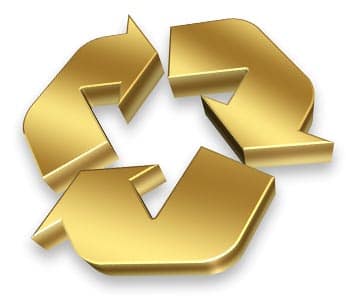In tandem with gold supply falling 2% in 2014, gold recycling levels have also decreased to their lowest levels in 7 years. (Highest levels seen between 2009 and 2012). In 2013, gold recycling fell 11%.
What this means? According to World Gold Council: Gold Demand Trends Report 2014, gold recycling will remain low and will likely continue to decrease because of recent surges in gold demand in China and India. In other words, because of gold recycling contributes a significant percentage of gold supply, with the increase in demand flushing out gold supply, channels toward gold recycling are tightening. This is an interesting observation mainly because in a later report by World Gold Council drivers of recycled gold supply were its ability to a) increase over time, b) economic crisis, and c) changes in gold prices. While these are undoubtedly true, we are also seeing how gold demand is stemming some drivers (a & b), and reinforced by others (c).
Nonetheless, gold recycling remains to be an important contributor to the overall supply of gold, and a fascinating topic to those analyzing the gold market. Of the 4278.2 tonnes of gold supplied in 2014, gold recycling made up 26% at 1172.7 tonnes. This number is a a lot higher than most people realize, and although gold mining still supplies most of the world’s gold, recycling helps balance the gold market by alleviating some of the pressure off of the mining sector to supply gold demand, which was 3923.7 tonnes in 2014. In addition, one has to consider that, the environmental (as well as production) costs are far, far smaller than gold mining. In an article on Bullionstreet.com, they cite that environmental groups who focus on the environmental degradation of gold mining say to mine an 18k ring leaves behind 20 tons of ore and rock waste.
Countries with high demand vs. their recycling (2012)
India: Demand vs Recycle: 864.2 tonnes vs 113 tonnes
China: Demand vs Recycle: 817.5 tonnes vs 120 tonnes
United States: Demand vs Recycle: 161.8 tonnes vs 129 tonnes
Italy: Demand vs Recycle: 23.5 tonnes vs 123 tonnes
The four countries listed are the top 4 countries leading in gold recycling, however, the demand in China and India far exceeds their recycled supply, thus relying on gold mining and imports from other countries. Together, China and India make up over 40% of the world’s demand, yet they contribute roughly 20% of the world’s recycled supply. In other words, to meet the current demand for gold, the world still heavily relies on gold mining, while, at the same time, gold recycling wanes because demand implies “buying”, thus people aren’t selling to recycling companies. This creates an issue for recycled supply because if people aren’t selling gold to be recycled, then the recycling supply cannot keep up with growing demand. We see this most starkly in 2014 when prices were low, encouraging buying (increase in demand) and discouraging selling (decrease in recycled supply).
As much as there is an environmental upside to gold recycling, it is firmly dependent on the price of gold, and global supply and demand. Another factor which affects the recycling supply is the duration of which gold is held, especially jewelry. Disregarding intrinsic value and its relationship with the gold prices, sentimental value and religious significance keeps gold off the trading table. Considering that 90% of recycled gold is high value gold, according to World Gold Council’s The Ups and Downs of Gold Recycling article posted earlier this year, the time it takes to sell gold jewelry and reluctance on the part of the seller certainly does not stave off growing demand. Recycling supply is forced into a waiting game with its only incentive to offer are gold prices, which, if they are low, hardly is enough incentive for sellers.
Nonetheless, there are opportunities for recycling gold in industrial supply materials, such as electronics, making up 10% of supply. This is low compared to high value gold, but there is room to grow and has, in fact, doubled in the last ten years. While it has been known that electronics contain precious metals, the belief is that it is difficult and expensive to extract them for recycling. Between 15 and 20% of precious metals are recycled from electronics, the rest are thrown out. However, technology is developing to make extraction simpler and cost-effective, as well as advertised appropriately to encourage people to recycle their electronics more so in our electronic/mobile heavy society. In 2012, 400,000 tonnes of industrial waste was available for recycling, and is expected to grow to 2,000,000 tonnes by 2025. When we think that gold recycling is currently capturing 15-20%, that is a lot of recycled gold to potentially miss out on.
Overall, for gold recycling companies, whether it is for high value gold or industrial gold, there are pressures as well as opportunities. Low gold prices coupled with high gold demand in the East is diverting the attention of producers and sellers away from recycled gold which continues to give mined gold an important place in the supply side of the market. On the other hand, industrial waste is an avenue that gold recyclers can capitalize on as confidence grows and extraction methods develop.
